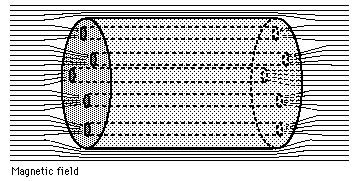Cold dense flowing plumes connect the cores and magnetic field lines together of the earth and sun
Cold plumes of dense particles in filaments during electrical thunderstorms have been observed to contact earth's surface, and extend into the magnetosphere, connecting the magnetic fields lines of the earth with the sun's magnetic field lines. The cores of both the earth and sun are connected together by this cold superfluid, strongly suggesting that the cores of the earth and sun have very cold regions.
New Outer Space Stories - RSS Feeds
-
The best streaming device out there: Which one comes out on top — Amazon
Fire TV Stick, Roku Ultra, Apple TV and Google TV Streamer?
-
Which is the best streaming device out there? We've pitted four of the best
models on the market against each other to determine the top option.
2 hours ago
-
Gemini and Blanco telescopes unlock clues to origin of longest gamma-ray
burst ever observed
-
Gamma-ray bursts (GRBs) are among the most powerful explosions in the
universe, second only to the Big Bang. The majority of these bursts are
observed to f...
4 hours ago
-
Roman Soldiers Fought an Invisible Enemy Inside Their Own Fort
-
[image: Attacking Roman Soldier]Researchers analyzing ancient sewer drains
at the Roman fort of Vindolanda near Hadrian’s Wall have found clear
evidence th...
4 hours ago
-
Before We Build on the Moon, We Have to Master the Commute
-
[image: The Orion Capsule takes a "selfie" with the Moon and Earth. Credit
- NASA]
Even most rocket scientists would rather avoid hard math when they don...
5 hours ago
-
AI systems proposed to boost launch cadence reliability and traffic
management
-
Tokyo, Japan (SPX) Dec 26, 2025
The global space sector is entering a phase of large-scale satellite
constellations and expanded human lunar activity, drivi...
14 hours ago
-
18,000-Year-Old Circular Dwellings Made of Mammoth Bones Unearthed in
Ukraine
-
[image: Reconstruction of Mezhirich’s mammoth bone structure in the
National Museum of Nature and Science, Tokyo, Japan. Image credit:
Momotarou2012.]
The...
20 hours ago
-
Stuart Talbott: Science Shocked to Find Lightning Going on Mars |
Thunderbolts
-
Since 2022, NASA’s Martian rover Perseverance has been documenting direct
evidence of lightning on the red planet. The rover’s super-cam microphone
has ide...
5 days ago
-
Science Release: Hubble sees asteroids colliding at nearby star for first
time
-
[image: Fomalhaut cs1 and cs2 (annotated)]In a historical milestone,
catastrophic collisions in a nearby planetary system were witnessed for the
first time...
1 week ago
-
We test Celestron's 10-inch StarSense Explorer
-
*This scope uses your smartphone to put thousands of deep-sky objects at
your fingertips.*
2 years ago
-
Hidden Supersymmetry of Electrostatic Fields
-
Juan D. García-Muñoz, A Raya A hidden supersymmetry of electrostatic fields
is evidenced. Proposing an ansatz for the electrostatic potential as the
natura...
3 years ago
-
Scientists Uncover Warehouse-Full of Complex Molecules Never before Seen in
Space
-
Scientists have discovered a vast, previously unknown reservoir of new
aromatic material in a cold, dark molecular cloud by detecting individual
polycycl...
4 years ago
-
1메모리 6기가 peteuplink
-
1메모리 6기가 peteuplink
5 years ago
-
The Fall and Rise of Betelgeuse
-
With its recent uptick in brightness, Betelgeuse appears to be slowly
returning to normal. But will it? Astronomers urge us to keep watch.
The post The F...
5 years ago
-
Welcome to Catch a Star
-
School students around the world are invited to take part in the 2019 Catch
a Star astronomy writing contest. To participate, students should submit a
writ...
6 years ago
-
Astronomers discover extremely hot, pitch-black exoplanet
-
Using the Hubble Space Telescope, astronomers have discovered a most
unusual exoplanet that reflects 94% of the visible light given off by its
host star,...
8 years ago
-
Super Volcano! History's Great Secret: The Global Catastrophe of 535 AD
-
Super Volcano!
*History's Great Secret: The Global Catastrophe of 535 AD*
[image:
https://upload.wikimedia.org/wikipedia/commons/8/80/Super-volcano_Tie...
8 years ago
-
Astronomers observe star reborn in a flash
-
An international team of astronomers using Hubble have been able to study
stellar evolution in real time. Over a period of 30 years dramatic
increases in...
9 years ago
-
Mystery Plumes: Did the Sun Bruise Mars?
-
Strange plumes have been spotted high in the Martian atmosphere that have,
so far, defied explanation. Now scientists think space weather is to blame.
9 years ago
-
-
Giant Bow Shock in Space
-
The beautiful image above shows a giant bow shock wave in space around a
young star. The name of the star is LL Ori and it is located in one of our
favor...
11 years ago
-
-
-
-















No comments:
Post a Comment